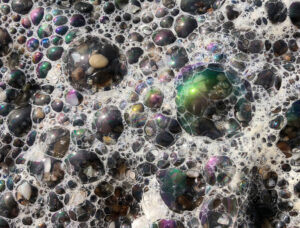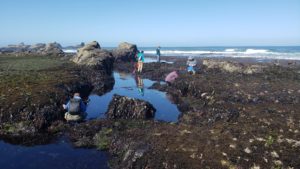Usually around late April, following spring storms, Northern California beaches are littered with something that looks like gobs of purple-tinted slimy cellophane. On close inspection, if you pick up a piece of this stuff, you will have in your hand a two- to three-inch oval-shaped animal with a purple fringe around its border and a small, graceful sail standing up perpendicular to the base. The common name for this creature is “by-the-wind-sailor,” but I prefer its more musical Latin name, Velella velella.
But what exactly have you picked up? Though it arrives on our shores in vast numbers every year, the Velella has a natural history that is still a bit mysterious. We do know that while it is very hard to feel a sting from these animals, they are in the “stinging nettle,” or Cnidaria, phylum (along with the corals and jellyfish). We also know that they are pelagic animals—they live on the open sea and migrate around the ocean throughout their sailing life. Pacific tuna are pelagic, as are the pelagic crabs that sometimes wash up on our shores, but the Velella don’t have a sophisticated means of propulsion as tuna or pelagic crabs do.
What each Velella does have is a sail, and herein lies the beauty of the species: It relies entirely on ocean currents and prevailing winds to get around. Its sail is not a simple “sheet in the wind”; rather, if you look down at it from the top, it has a very gentle S-curve in it. This curve allows the organism to set itself in juxtaposition to the wind so as to create a pressure gradient across the leeward side of the sail. Sailboats rely on a single pressure gradient—a high pressure behind the sail and a lower pressure in front of the sail to propel the boat. The S-curve in the Velella creates this pressure gradient across both the front and back surfaces of the sail. This feature allows for some variability in their direction of travel—hinging on the angle of the sail against the wind.
There is not really much more to the Velella‘s transparent body than what you can see. While they are composed of many cell types, they only have two types of tissue in their bodies: the epidermis (or supporting body), and the gastrodermis, their digestive system—all hung on a chitinous “arbor.” Their bodies serve as a support structure for the quarter- to half-inch-long purple tentacles, which they use to catch small prey floating near the surface. They don’t appear to have circulating body fluids, a propulsion system, or even a brain.
But their apparent simplicity belies somewhat complex adaptations to their pelagic existence. For example, they are polymorphic—that is, many-formed—in two ways. First, in their breeding phase they are in a free-swimming medusa form, while otherwise they are in their migrating phase as sailors. Their other dimorphism is in their sails, which can be in a “left sail” or “right sail” configuration, which sail to the left or right of the wind, respectively. The Velella we see on our coast are mostly “lefties,” while those south of the equator on the Pacific coast are “right sailed.” This dimorphism probably evolved as a consequence of the prevailing winds in each hemisphere.
While the general biological consensus is that a single Velella is an autonomous organism, it does appear on the sea surface in large aggregations—which it has been doing for at least 350 million years. Due to that long history of aggregation, I suspect these creatures do better as a group—and that they have a better chance of surviving the torments of the sea by rafting together. I wouldn’t speculate as to how many Velella constitute a successful raft, but I have seen rafts out at sea as large as a soccer field. Since I first encountered these creatures, I’ve had a research fantasy of traveling with them in a craft patterned after their elegant little bodies—mimicking the set of their collective sails to see where and how they travel. I’m sure my fantasy model is far too simple to work: The delicate winds just above the water’s surface, the motion of the waves, and the action of the water just below the surface tension of the sea would likely be too subtle to effectively propel a human-bearing craft. But even if it did work, the mysterious global wanderings of the Velella velella wouldn’t have a place for a tagalong naturalist.





